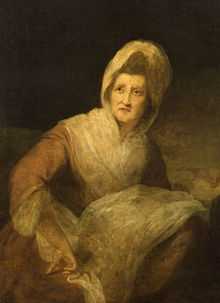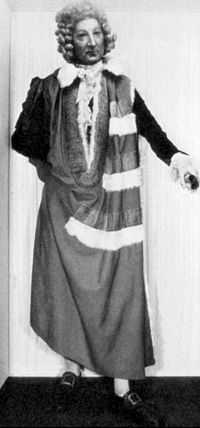Patience Wright
| Patience Wright | |
|---|---|
 Portrait of Patience Wright | |
| Born |
Patience Lovell 1725 Oyster Bay, New York |
| Died |
March 23, 1786 London, England |
| Known for | Sculpture |
| Notable work | lifesize wax sculptures |
Patience Lovell Wright (1725 – March 23, 1786) was the first recognized American-born sculptor. She chiefly created wax figures of people. She loved to write poetry and was also a painter.
Biography
Patience Lovell was born at Oyster Bay, New York, into a Quaker farm family with a vegetarian diet. The family moved to Bordentown, New Jersey when Patience was four years old. At age 16 she left the family home and moved to Philadelphia, where in 1748 she married Joseph Wright, a barrelmaker who was many years her senior.[1] For years she had amused herself and her children by molding faces out of putty, bread dough, and wax.
After her husband died in 1769, to support herself, her children and the new child on its way, she (working with her sister Rachel, who by then was also a widow) turned her pastime into a full-time occupation molding portraits in tinted wax, which was popular art form in colonial America. She had an "energetic wildness" when she worked for she loved the work she did.
By 1770, Patience and Rachel had become successful enough to open a waxworks house in Philadelphia and another in New York City. The Manhattan outpost, on Queen Street, was the more successful of the two, but when fire ravaged the block in June 1771, all of Wright’s work was destroyed.
After the fire on Manhattan Outpost she decided to relocate to London to pursue her trade there. She had acquired the public support of Benjamin Franklin through her acquaintance with his sister, Jane Mecom.
Armed with a letter of introduction from Franklin, she was quickly accepted into London society, although her unorthodox comportment (she wore wooden shoes, and kissed members of both sexes and all classes, on both cheeks), caused her to be labeled "The Promethean Modeler".
She was patronized by George III, and sculpted him and other members of British royalty and nobility, but fell from royal favor because of her open support for the colonial cause during the American Revolution. She sculpted wax figures of both loyalist and patriots.
American Revolution
According to some books, she became a spy for the cause, sending information overheard from her subjects on how the British were preparing for the war to America inside her wax figures. When Wright was constructing sculptures of Patriot sympathizers, she didn't want anyone who may inform the King to know. So if she had visitors while constructing the sculptures she would hide the bust underneath her apron and try to distract her visitor by engaging in a conversation.
Wright's sculpture of friend William Pitt still stands in Westminster Abbey Museum. Other notable subjects she modeled included Lord Lyttelton, Thomas Penn, Admiral Richard Howe, and Charles James Fox. Some of Wright's supporters include Benjamin Franklin, Deborah Sampson, the King and Queen of England, and William Pitt.
After Independence

After the War of Independence turned to open rebellion, Wright's trade decreased dramatically. Her name, seen often in London newspapers, is found no more after 1776. Her access to British royalty became restricted, especially after she reportedly scolded the king and queen after the battles of Lexington and Concord.
By 1780 she was out of work, so she relocated to Paris, hoping to open another waxworks there. She made another bust of Franklin, and tried to work her way into Parisian society, but was largely unsuccessful. She returned to London in 1782 and began writing to American notables including George Washington and Thomas Jefferson, requesting permission to model them. No evidence exists that they returned her correspondence.
By 1785 she had determined to return to New Jersey. However, as she was making preparations to travel, she suffered a bad fall, and broke her leg. She died a week later, on 23 March 1786. Her sister Rachel attempted to get financial assistance for her burial expenses, both from prominent American citizens and then from the Continental Congress, but was not successful. As a result, Wright was buried in London, in a place now lost to history.
Patience Wright's son Joseph Wright (1756–1793) was a well-known portrait painter who designed Liberty Cap Cent. Her daughter Phoebe married British painter John Hoppner; their son, Henry Parkyns Hoppner, went on to become a Royal Navy officer and Arctic explorer.
Her home at 100 Farnsworth Avenue in Bordentown, New Jersey still stands.[2][3]
Surviving works, and legacy
The only remaining wax figure made by Wright is a bust of William Pitt, and it was produced after the Earl’s death. It is exhibited in Westminster Abbey. Wright's house in Bordentown is still standing, and is identified as such on local literature. Several portrait paintings of Wright were produced during in her lifetime, and they are still available.
Wright's sister Rachel wrote to Benjamin Franklin, requesting financial assistance toward Wright's burial. No record of a reply now exists, even though the sister took the matter all the way to the Continental Congress. As a result, Wright was buried in London in a site which has been lost to history. Patience Lovell Wright and Joseph Wright were the parents of five children.[4]
In literature
Wright was featured as a character in Lillian de la Torre's story "The Frantick Rebel," part of her series featuring Samuel Johnson as a detective, with Wright successfully tricking Johnson into supplying information to an American spy.
References
- ↑ "Patience Lovell Wright", Bordentown Historical Society.
- ↑ Downtown Bordentown Association
- ↑ Patience Lovell Wright House Historical Marker
- ↑ The Madame Tussaud of the American Colonies Was A Founding Fathers Stalker, Smithsonian.com Weekly Newsletter (29 December 2013)
External links
- Union List of Artist Names, Getty Vocabularies. ULAN Full Record Display for Patience Lovell Wright. Getty Vocabulary Program, Getty Research Institute. Los Angeles, California.
- http://www.rabungap.org/uploaded/faculty/twass/American_History/Historical_Figures_for_Colonial_Town_Meeting.htm
- http://www.npg.si.edu/col/age/wright.htm
- http://score.rims.k12.ca.us/score_lessons/women_american_revolution/wright.html
- Burstyn, Joan N. Past and Promise: Lives of New Jersey Women (Syracuse University Press, 1997)
- Kerber, Linda K. Toward an Intellectual History of Women: Essays (Univ. of North Carolina Press, 1997)
- Lepore, Jill. Book of Ages: The Life and Opinions of Jane Franklin (Knopf, 2014)
- Mays, Dorothy. Women In Early America: Struggle, Survival, and Freedom in a New World (ABC-CLIO, 2004)
- Sellers, Charles Coleman. Patience Wright: American Artist and Spy in George III's London (Wesleyan University Press, 1976)
- To George Washington from Patience Lovell Wright (8 December 1783), Founders Online, National Archives
- To Thomas Jefferson from Patience Wright (14 August 1785), Founders Online, National Archives
- The Papers of Benjamin Franklin, The American Philosophical Society and Yale University
|